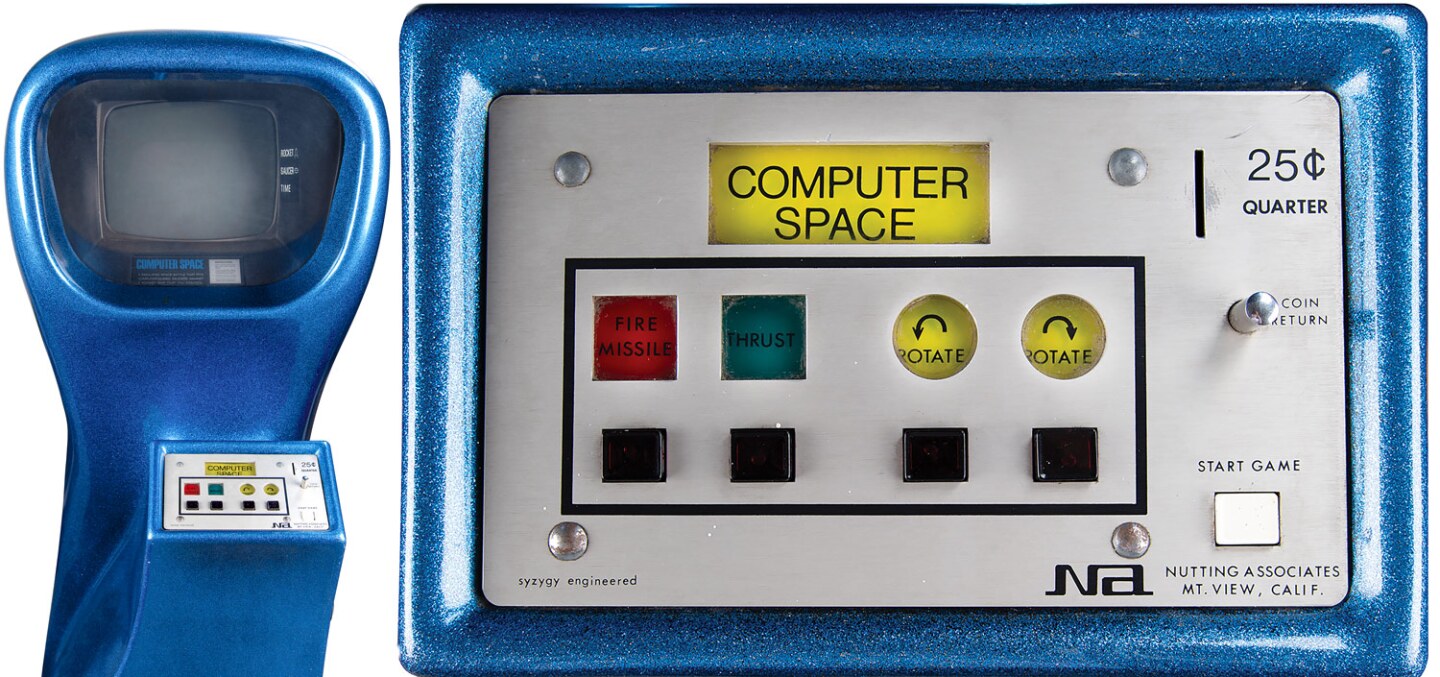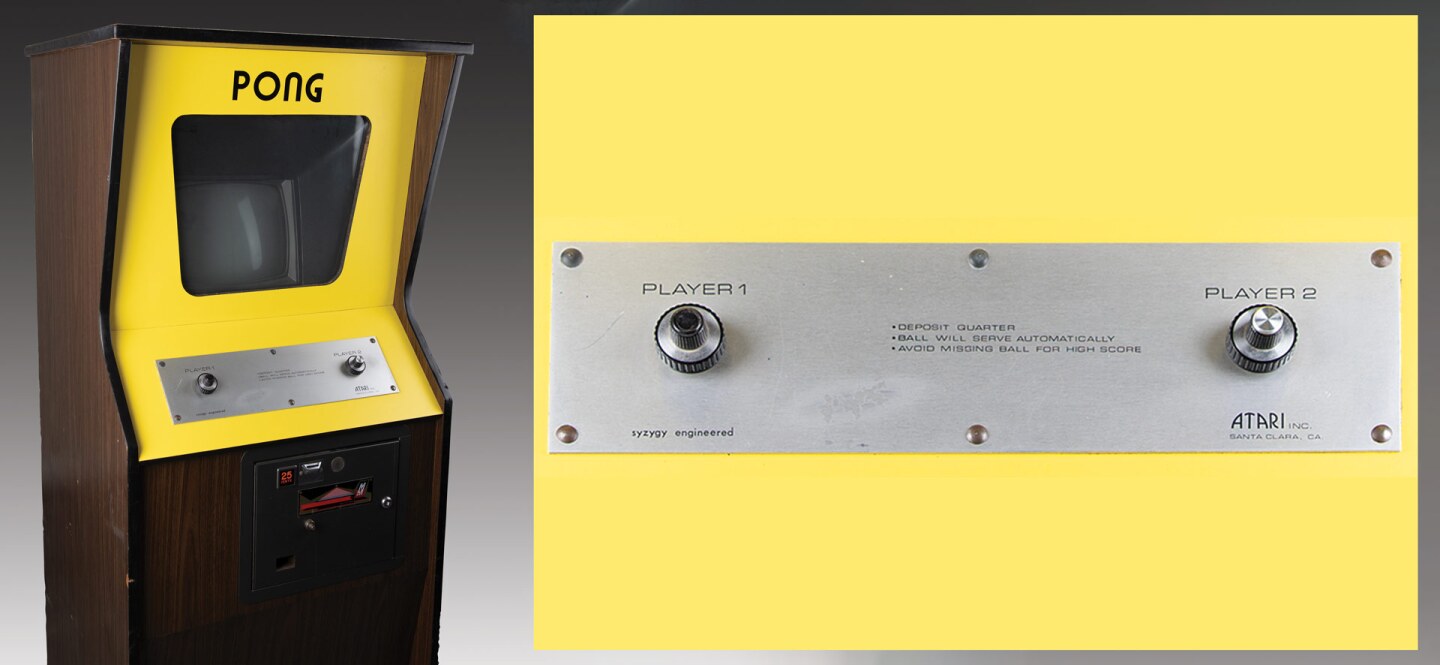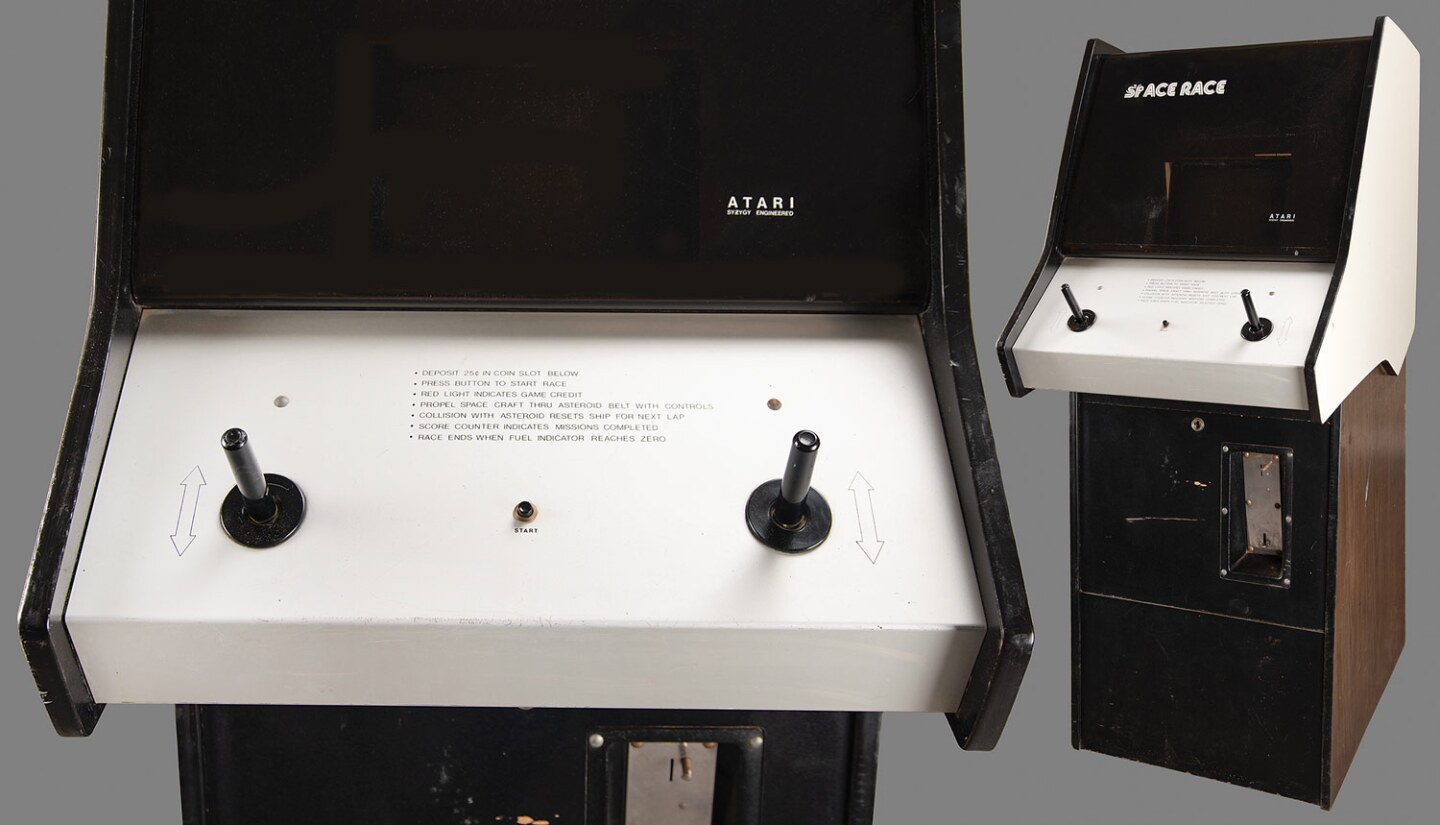Landmark historical relics don't usually slip past at public auction unnoticed, but as we demonstrated in this recent article, it does happen. Now three priceless relics from gaming antiquity are going to auction: the world’s first video arcade game (Computer Space - 1971), the game it inspired (Pong - 1972) and the sequel to Pong (Space Race - 1973) which used the world's first computer joystick.
When we say priceless, that's not exactly true. The three gaming machines, which would be the cornerstones of any museum display wishing to preserve our technological heritage, have price estimates from RR Auctions of (USD) $20,000+ for Computer Space, $10,000+ for Pong and $10,000+ for Space Race.
If that seems kinda cheap, we agree.
The marketplace for scientific memorabilia has always been undervalued in comparison to sports, music and entertainment memorabilia, but we are still in the the wash cycle of the "fourth industrial revolution" and memorabilia from the video and computer gaming industries seems even more undervalued considering gaming's massive adoption by and influence upon society.
These machines mark the very beginning of an entertainment genre that is now three times larger than the music and movie industries combined – you can't see how big the gaming industry is because most of it happens online, and the latest gaming usage statistics offer some perspective on just how much share of humanity's discretionary time that gaming has claimed.
The Entertainment Software Association is the voice of the video game industry, and it produces an annual compendium of research with the latest being the 2023 ESA Essential Facts.
The 2023 study found that 58% of American gamers now use multiple platforms.
The mobile phone is now the most commonly used gaming platform, being used by 64% of gamers, ahead of gaming consoles (54%), PC/laptops (45%), tablets (24%) and VR headsets (10%).
Given that two-thirds of the planet's humanity now carries a mobile device suitable for gaming in their pocket, it's difficult to see any other gaming platform challenging the smartphone any time soon.
Gaming has already emerged as the primary form of entertainment on the planet. Over half our time online is spent on mobile phones. Two thirds (65%) of all Americans and three-quarters (76%) of all Americans under 18 play at least one hour a week. Three-quarters (75%) of all American game-players spend more than four hours a week gaming and the average for all American game players is 12.8 hours a week. Gen Z boasts the highest percentage of regular gamers at 66% and 42% of Americans have been playing video games for more than 20 years.
Now given that the movie, music, sport and entertainment categories have been going a lot longer, gaming will eventually dominate all those categories to such an extent that its memorabilia prices should be at least on a par with those other industries one day.
There are many artefacts from the high points of those industries that sell for millions at auction, yet a working example of the world's first video arcade game selling for $10,000 is still the norm. We don't think it will stay that way.
Together, the three arcade games going to auction at RR Auctions on 21 March 2024 represent the key learnings and landmark releases from the early years of video gaming.

RR Auction
Computer Space (1971) was the first arcade video game as well as the first commercially available video game. It was derived from the world's first computer game, the space combat computer game Spacewar! which had been written in 1962 by a group of students at the Massachusetts Institute of Technology for its then newly-installed DEC PDP-1 minicomputer.
Computer Space was the work of Nolan Bushnell and Ted Dabney before they changed their company name from Syzygy Engineering to Atari. Its arresting fiberglass "space age" cabinet was styled by a friend of Bushnell's who made Jacuzzis and it certainly looked the part. The environment for the launch of a space combat arcade game seemed perfect. 723 million people had watched Neil Armstrong walk on the Moon in 1969, and the USSR launched the first space station in April 1971, and the American-Soviet space race was part of the era.
Sadly, Computer Space was a little too complicated, the controls were out of the player's vision and far from intuitive, the learning curve was very steep, and you had to read instructions ... FAIL!
Ultimately, Computer Space sold somewhere between 1,300 and 2,000 cabinets, which was far below expectations.
Bushnell told the New York Times in 1981, ''It was a great game. All my friends loved it, but all my friends were engineers. The beer drinkers in the bars were baffled by it. I decided what was needed was a simpler game.''

RR Auction
Bushnell figured that Computer Space failed because it was too complicated, and the fundamental lessons learned from its failure helped to design Pong, drive Atari from zero to a $450 million company in a blink and inform a young Steve Jobs about the importance of a simplistic Computer Human Interface.
Steve Wozniak is an Atari alumni. Steve actually created the 1976 "Breakout" arcade video game for Atari, based on a conceptualization from Nolan Bushnell and Steve Bristow.
Jobs is also an Atari alumni and was mentored by Allan Alcorn, who had plucked the jammed coin from the Pong prototype in Andy Capp's Tavern and lived the evolution of the computer game from the most advantageous perspective – as head of engineering for a world-leading juggernaut games company. A few years ago, an Apple II computer came to auction with a fascinating story attached to it. It was a very early Apple II given by Jobs to Alcorn in appreciation of the help Alcorn had given him in getting Apple off the ground.
Alcorn hired Jobs at Atari, and was a key factor in Jobs' formative business years. In addition to this mentoring, Alcorn introduced Jobs to potential investors in his new company (Apple) and he even provided computer chips to Apple at cost in the very early days when it really counted. When Apple was beginning to show signs of the massive success that followed, Jobs offered Alcorn equity in Apple for the help he had given him and Alcorn said he said he'd take a free Apple II instead. This wonderful connection between two of the world's most accomplished digital super heroes pushed the price of the computer to roughly 20x market value when it was bid to $20,610 at this same March RR Auction in 2022.
It could easily have been more, but the story illustrates how close Steve Jobs and Steve Wozniak were to the real life lessons of Bushnell and Alcorn about the critical importance of the Computer Human Interface – no doubt many of these lessons were put to good use as Apple sculpted its computer usability to unprecedented levels with the graphical user interface and the mouse.
To get traction, Nolan Bushnell dumbed down the game and the interface to astonishingly simplistic levels. From the very first day, Pong attracted customers at four times the rate of previous gaming machines of any genre.
A Pong arcade game is now part of the permanent collection of the Smithsonian due to its cultural impact.

RR Auction
Atari's follow-up to Pong was the Space Race arcade video game that was released on 16 July 1973, and while it isn't the first arcade game to feature a joystick controller, it was the first of note in the arcade game space and demonstrated Atari's commitment to simplifying the interface even further. This was the game that introduced joysticks to the world of arcade gaming.
Alcorn's implementation was so good that both Nintendo and Sega copied aspects of it and were ultimately successfully sued by Atari.
These three arcade games as a set, tell a story that will one day recount the very beginnings of an entertainment genre that has become, and will remain, humanity's favorite pastime for the foreseeable future. Shouldn't they be in a museum?
https://news.google.com/rss/articles/CBMiXWh0dHBzOi8vbmV3YXRsYXMuY29tL2dhbWVzL2NvbXB1dGVyLXNwYWNlLXBvbmctc3BhY2UtcmFjZS1waXZvdGFsLXZpZGVvLWdhbWVzLWZyb20tZWFybHktNzBzL9IBAA?oc=5
2024-03-12 11:35:30Z
CBMiXWh0dHBzOi8vbmV3YXRsYXMuY29tL2dhbWVzL2NvbXB1dGVyLXNwYWNlLXBvbmctc3BhY2UtcmFjZS1waXZvdGFsLXZpZGVvLWdhbWVzLWZyb20tZWFybHktNzBzL9IBAA
Bagikan Berita Ini














0 Response to "Dawn of the arcade game: Three pivotal video games from the early 70s - New Atlas"
Post a Comment